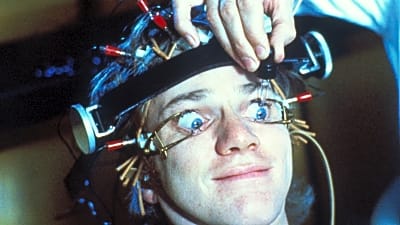The prequel comic book is certainly nothing new. Horror is a genre that offers particularly rich fodder for prequel exploration, and it lends itself very well to comic-book merchandising. Sure, full-on novelizations provide richer prose and character development, but a book with images enables you to tell a story without skimping on the spooky and grisly visuals that horror enthusiasts live for.
In the horror genre, classic franchises such as “Hellraiser,” “Friday the 13th,” “A Nightmare on Elm Street,” and “The Texas Chainsaw Massacre” have all received the prequel comic book treatment. But what other iconic horror movies deserve to have some backstories fleshed out in graphic-novel format?
1. “The Cabin in the Woods” (2011)
If you’ve seen this ingeniously meta horror comedy all the way to its ending, you know that the only way its lore can be expanded is by looking backward. “The Cabin in the Woods” holds the potential for some of the most ambitious world-building of any horror film: it rests on the premise that the fate of our planet is in the hands of some volatile underground deities known as the Ancient Ones, who must be appeased by no fewer than one human-sacrifice ritual per year.
Now, if humankind wants to keep these Ancient Ones pacified, we can’t just throw somebody into a volcano and call that a ritual. Every country on Earth operates a top-secret, high-tech lab from which a team of technicians orchestrates the elaborate sacrifice of a group of unsuspecting victims. Each ritual mirrors the horror traditions of its respective culture, and each lab comes equipped with an immense menagerie of horror-movie monsters. Just the American lab alone (the only one seen in the movie) contains everything from a ghost to a unicorn to multiple species of zombie.
Already, it’s easy to imagine a hundred different issues of a prequel comic book for “The Cabin in the Woods.” Between all the labs that must exist all over the world and all the rituals that must have been carried out for however many millennia, it’s a comic-book series that could practically continue into perpetuity. And that’s before we consider the possibility of exploring how the Ancient Ones first came into being, and what the rituals may have looked like before modern high-tech labs existed.
2. “The Descent” (2005)

This classic of noughties horror is a uniquely well-made and horrifying depiction of a spelunking adventure gone horribly wrong, and it’s commendable for the depth of its strictly visual world-building regarding the humanoid, human-eating “crawlers” that menace the trapped spelunkers. It’s these creatures that would make excellent fodder for a prequel comic book.
The appearance of the crawlers bears the influence of Gollum and numerous Hollywood aliens. But in a contemporary interview with The Northern Echo, director Neil Marshall explained that it was very important for his creative team not to think of them as generic, fantastical alien monsters. In an effort to make them seem more like a believable species than a supernatural force of evil, “The Descent” features crawlers of both sexes (differentiated by the amount of hair they have) and numerous ages. The article describes them as “cavemen who never left the caves.”
The speculative evolution (spec evo) genre of science fiction has no shortage of online enthusiasts, but (the iconic Xenomorphs notwithstanding), it’s not every day that these fans can satisfy their appetites with horror movie lore. A prequel comic book for “The Descent” could tell the story of how, say, a Pleistocene tribe of Clovis people came to live their entire lives deep in the cave systems of what is now North Carolina, where they became so environmentally well-adapted that they were eventually no longer human. There wouldn’t be any dialogue in such a comic – just prehistoric tableaux depicting evolution and daily life for the crawlers and their ancestors.
3. “Get Out” (2017)

Modern horror auteur Jordan Peele delivered one of the most galvanizing directorial debuts of all time with this thoroughly chilling tale of an affluent White community whose insidious oppression of Black people has more sinister depths than even the wary protagonist Chris Washington (Daniel Kaluuya) ever imagined.
While meeting the family of his girlfriend Rose Armitage (Allison Williams), seemingly the only White character who is aware of how racially cringeworthy the White people surrounding her are, Chris makes a shocking discovery that’s practically an in-film prequel comic book in its own right: contrary to her claim that he’s the first Black person she’s ever brought home to her family, a photo album in her closet shows her with numerous others, proving that he can’t trust even her. He’s just the latest of many Black significant others – the latest of many such victims.
Imagine a prequel comic book focusing on Rose’s long history of meeting, grooming, and abducting African-Americans. We already know her full modus operandi: a particularly horrifying late scene in the film shows her searching online for her next would-be target. A “Get Out” prequel comic could be very extensive, with no fewer than nine issues focusing on each of the victims shown in the film. (And those are just the ones we know about). This would enable the series to showcase a diverse array of Black victims, putting a human face on the unspeakable entirety of the Armitages’ latter-day slave trade.
4. “28 Years Later” (2025)

In a way, this recent post-apocalyptic virus film has already gotten the prequel comic book treatment, seeing as how the original film in its franchise, 2002’s “28 Days Later,” got its own comic series focusing on events following the end of that film. However, that was back in 2009-11, well before “28 Years Later” was ever conceived of. The new film not only represents a huge chronological leap forward from its two predecessors (the more recent of which was 2007’s “28 Weeks Later”) but also makes some extremely fresh and fascinating additions to the franchise’s lore.
“28 Years Later” introduces an island community of uninfected survivors, who have developed a medieval-esque agrarian society that is unique and fully realized onscreen. A prequel comic book series that fleshed out its history and culture even further would be a welcome addition to this lore – and we learn in-film that this is just one of many cultures to spring up in Rage-ravaged Great Britain. The history of the Jimmies – a gang of effortlessly cool Infected-slayers who model themselves after Jimmy Savile (a posthumously notorious British celebrity who was likely never exposed as a sexual predator in this franchise’s alternate timeline of the country) would make for especially interesting lore-building.
And then there are the Infected themselves. These zombie-like victims of the Rage virus have evolved since the first days of the epidemic. As depicted in “Years,” they’ve changed into separate breeds so different in appearance and lifestyle that, like the crawlers in “The Descent,” they more resemble creations of speculative zoology than humans suffering from a horror-film plague. Unexplained, for instance, is how the Rage virus mutated to turn fast and vicious zombies into slothful worm-eaters who crawl across the forest floor. This is just the kind of backstory that’s ripe for a prequel comic book written by an author with a talent for purely visual storytelling.
5. “Talk to Me” (2022)

One of the single greatest horror films of the last five years, the haunting (in an emotional as well as paranormal sense) supernatural-possession flick “Talk to Me” already has a prequel film well in the works. This prequel will concern the kid who owned the hand immediately prior to the events of the original, but that film’s lore set up the potential for an even more intriguing history: the origin of the iconic ceramic hand around which the story revolves.
In “Talk to Me,” we learn via dialogue that this hand is a real human appendage that is merely embalmed in ceramic. This hand once belonged to a medium who had the power to communicate with deceased spirits, and whose hand was subsequently amputated – presumably against his will – for its supernatural powers.
In what era did this person live? Who, exactly, cut off his hand and under what circumstances? How did he ultimately die? What of his other hand, which reputedly still exists somewhere in the world? A prequel comic book could use some truly arresting visuals to answer these questions and more.
More must-reads:
Breaking News
Trending in Entertainment
Customize Your Newsletter
 +
+
Get the latest news and rumors, customized to your favorite sports and teams. Emailed daily. Always free!








